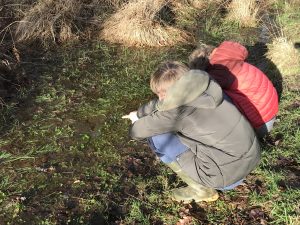Record-breaking New Forest frog spawn sighting added to national survey
30th January 2023
The New Forest’s first frog spawn sighting of the season has been added to an annual national survey. Spotted on 9 January by Amphibian and Reptile Conservation’s (ARC) senior ecologist Paul Edgar, this is the earliest ever recorded spawn sighting for Hampshire.
Led by national wildlife conservation charity Freshwater Habitats Trust, the PondNet Spawn Survey maps sightings of Common Frog and Common Toad spawn across the country to better understand how amphibians use different types of waterbodies to breed.
Freshwater Habitats Trust has been collecting data on breeding frogs and toads since 2012. Each year since then, people across the country have got involved by recording spawn they have spotted in their garden or community ponds, or in the countryside. The first 2023 PondNet Spawn Survey entry was from the Isles of Scilly on 23 December, followed by two sightings in North Devon in the New Year.
Paul Edgar has been monitoring spawn in the New Forest for 11 years, He noticed the spawn in a shallow trackside ditch in a forestry inclosure, an area of the New Forest which is fenced off from roaming livestock for timber production. Although this sheltered habitat is typically the first place he sees spawn each year, this year’s sighting was a week earlier than any of his previous records.
Initially as a volunteer, and now collecting data for Amphibian and Reptile Conservation’s National Amphibian Survey, Paul has surveyed 124 spawning sites across a 300 hectare patch of the New Forest each year since 2013. He is now preparing to publish the first 10 years’ of results with Freshwater Habitats Trust, the University of Cambridge and Forestry England.
 Paul Edgar’s children at the site where the spawn was found.
Paul Edgar’s children at the site where the spawn was found.
Paul Edgar said: “Spawning season always starts early in this particular inclosure, so I wasn’t surprised to see it here first. However, I was surprised to see it as early as 9 January, which is six days earlier than any previous records for the first frog spawn in Hampshire.
“Across most of the New Forest, the spawning season generally gets underway in early February and we don’t yet know why spawning at this site seems to be starting earlier. Through projects like the PondNet Spawn Survey and National Amphibian Survey, we can start to map trends and understand more about how amphibians are using different types of habitats to breed and if a changing climate is having any effects.
“I hope that other people in the New Forest will be inspired to keep an eye out for frog and toad spawn and add their entries to the 2023 PondNet Spawn Survey.”
Freshwater Habitats Trust Director of Policy and Research Dr Naomi Ewald is also based in the New Forest, where the charity co-hosts the New Forest catchment and carries out practical conservation work to protect freshwater wildlife. She said: “Frog spawn is one of the first signs of spring and it’s really exciting to see the New Forest’s first entry to our PondNet Spawn Survey. This is an unusually early sighting for this part of the country and we’re very grateful to Paul for alerting us to it.
“With its pristine, unpolluted ponds, pools and springs, the New Forest is an internationally-significant landscape for freshwater wildlife. The PondNet Spawn Survey is a fantastic way for people to connect with the Forest’s diverse freshwater habitats and get involved in an important survey.”
 Paul Edgar’s son at the site where the spawn was found
Paul Edgar’s son at the site where the spawn was found
Anyone can upload PondNet Spawn Survey data, adding a grid reference, the nearest postcode or using the What3Words app, on the Freshwater Habitats Trust website. The charity is also encouraging people to share photographs of frog and toad spawn they have spotted on social media, using the hashtag #SpawnSurvey
Spawn facts
- Amphibians live on land for much of the year, but return to ponds to breed in spring. This means waterbodies can become extremely crowded.
- Frog spawn is laid in big clumps, whereas toad spawn forms long chains.
- Toad spawn is generally laid in deeper water than frog spawn.
- A single frog or toad will lay thousands of eggs. This is because eggs and tadpoles are very vulnerable to predators, so only a few will survive and become adults.
- It takes between two and four weeks for spawn to hatch and tadpoles to emerge.
